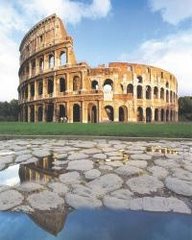Egyptian Obelisks
Rome has been nicknamed the city of obelisks, since it is the city with by far the largest number. At present there are thirteen, although there are legends of a fourteenth obelisk buried near the church of San Luigi dei Francesi. The Emperor Augustus was the first to raise them, bringing two from Egypt; Caligula followed his example by raising one in the Circus Vaticanus and building in the Campus Martius the large temple dedicated to Isis and Serapis, in the vicinity of which 5 obelisks were later found; many Roman emperors continued to erect obelisks down through the 4th century, including Constantius II, who in 352 erected in the Circus Maximus the obelisk that now stands in front of St. John Lateran, the tallest and oldest obelisk in the world. In fact, it is 32.18 metres tall and dates from the 15th century B.C.
For the ancient Egyptians the obelisks were the simulacra of the sun god Atum-Ra. The apex represented the starting point of the ray, i.e. the centre of the sun's power, while the base represented the formless matter that the divine light of the sun transforms into cosmos. The first obelisks were erected at Heliopolis, a city dedicated to the sun, and were usually erected in the centre of the sanctuaries and next to temples. They are the relicts of an extremely remote age, when even stones were objects of worship! In Rome they completely lost their original meaning, and took on another: that of a sign of the greatness of the Roman Empire first, and the papacy later.
The term we use today to refer to obelisks, different from that used by the ancient Egyptians, is of Greek origin: it derives from obelìskos, which means, perhaps with a hint of not-so-involuntary irony, "skewer".
To extract the huge monoliths from the quarries, the Egyptians allegedly used a tool similar to our drill, equipped with a sort of stone or bronze milling-cutter, whose abrasive action was greatly increased by the use of sand. Once it was detached from the rock, the obelisk was made to slide towards the river and hoisted up onto a large flatboat to be carried to its destination. The erection took place using an embankment: the progressive elimination of the sand on which it rested made it possible to bring the monolith down onto its base. The obelisks often broke during these long, delicate operations, as proven by the fragments found in the quarries or on riverbeds.
Our itinerary in search of ancient obelisks, often arranged by the popes in the centre of squares and crossroads as visual reference points, starts from piazza Navona. Here, in the centre of the area that recalls, with its perimeter, its original use for athletic games (see Itinerary 8), rises the famous Fountain of the Four Rivers, designed by Gian Lorenzo Bernini to support a magnificent obelisk.
The monolith of red granite, executed in the 1st century A.D. in imitation of the Egyptian ones to celebrate the Emperor Domitian, was perhaps intended for the Temple of Isis in the Campus Martius. In 309 the Emperor Maxentius decided to re-use it in the circus he had built along the Appian Way. After remaining for a long time broken into five pieces inside the circus, it was found again in 1649 and arranged by pope Innocent X Pamphili in its present position, in the centre of the fountain. Immediately afterwards the bronze point was placed on top, decorated on its tip with a dove carrying an olive branch, which belonged to the coat of arms of the Pamphili family: This way a strong symbolic connotation was given to the complex, because the papal dove dominates and transmits the truth of the Gospel to the four continents, depicted allegorically by the four rivers at the base. The Danube, the Ganges, the Rio della Plata and the Nile are represented as river gods, easily recognisable by their individual attributes. The Nile, in particular, has its face covered with a veil: not because, as suggested by the malicious, it does not want to see the façade of the church of Sant'Agnese, designed by Borromini, but to show the mystery that still surrounded the origins of the river's sources.
From piazza Navona we can go towards piazza della Rotonda, which takes its name from the cylindrical shape of the Pantheon (see Itinerary 8). In the centre of the square, which in shape resembles the arcade that probably surrounded the temple in Roman times, there is a fountain with a mixtilinear plan designed by Giacomo della Porta in 1575.
In the centre of the basin Pope Clement XI Albani, in 1711, ordered the erection of the obelisk that can still be seen there. The red granite monolith, 6.43 metres tall, comes from Egypt, where it had been erected by Ramses II in the 13th century B.C. in the city of Heliopolis. Brought to Rome in an unknown time, it was reused in the temple dedicated to Isis and Serapis in Campus Martius.
To eat, we can go to Via dei Pastini, where there is an excellent bread and pizza baker. Also on the same street, at no. 122-123, there is the restaurant Er faciolaro (06 6796280), specialised in Roman dishes.
Going along the left-hand side of the Pantheon, we reach the Piazza della Minerva decorated admirably by another monument by Bernini. The little obelisk of red granite, 5.47 metres tall, was constructed in the 6th century B.C. by the Pharaoh Apries, and was rediscovered in the Dominican convent of Santa Maria sopra Minerva.
Immediately after the discovery, Pope Alexander VII Chigi decided to erect it in the square in front of the church, and entrusted the design of the monument to Bernini, who thought up the elephant as a base. For the creation of the monument, Bernini allegedly drew inspiration from a novel published in the late 1500s by Francesco Colonna, mindful of the symbolism of Egyptian hieroglyphics. In fact, the stele should represent the divine wisdom that descends from the strong mind depicted by the elephant, as is also stated in the inscription on the base, with the warning from Alexander VII: "a strong mind is necessary to support solid wisdom". The monument is known today as the "Pulcino della Minerva" (Minerva's Chick), which derives from the 18th-century name of "Porcin della Minerva" (Minerva's Piglet), which stressed the elephant's resemblance to a piglet.
From the Piazza della Minerva we can go towards Piazza Montecitorio where, in front of the palazzo which is the seat of the Parliament, we see the red granite obelisk originally erected in the 6th century B.C. at Heliopolis by Pharaoh Psammetichus II, and transported to Rome by Augustus in 10 B.C.
Augustus used this obelisk as a gnomon, that is the style of a gigantic sundial constructed in the Campus Martius. It was supposed to project its shadow onto a marble-paved square, indicating the hours, seasons, signs of the zodiac and years, which were marked out in bronze. This sundial was not only a technological wonder: it had been constructed in relation to the Ara Pacis, which originally stood near the church of San Lorenzo in Lucina, and was regulated so as to direct its shadow towards the altar on the Emperor's birthday.
The obelisk was erected where it is today in 1794 as per the wishes of Pope Pius VI, who had it restored, filling in the missing parts with granite from the Column of Antoninus Pius, which was thus destroyed.
On the square is the characteristic Caffè di Montecitorio, whose clients include the deputies of the Italian Republic. On the nearby Piazza di Pietra is, instead, the famous Caffettiera, a renowned Neapolitan café.
We recommend that you now take the via del Corso and conclude this itinerary by reaching Piazza del Popolo. In the splendid setting of the square, stands the 23.9-metre-high obelisk dating from the 14th century B.C.
It was the first obelisk to be transferred to Rome in the time of Augustus, to celebrate the victory over Egypt, and it was originally set up in the Circus Maximus. Its present position, at the crossroads of the three streets that make up the so-called trident (via del Corso,Via di Ripetta and Via del Babuino), dates from 1589 and is due to the untiring work of the town-planner pope Sixtus V and his architect Domenico Fontana.
The architect and the pope moved three obelisks into the areas of three Roman basilicas: St. Peter's, Santa Maria Maggiore and St. John Lateran.
In the past the obelisk of Piazza del Popolo served as a source of fun for the Romans who, after blindfolding a playmate, would force him to walk from the obelisk as far as Via del Corso. It would be very difficult for the hapless victim to succeed, because he would be blocked by the obstacles he found along his way.












